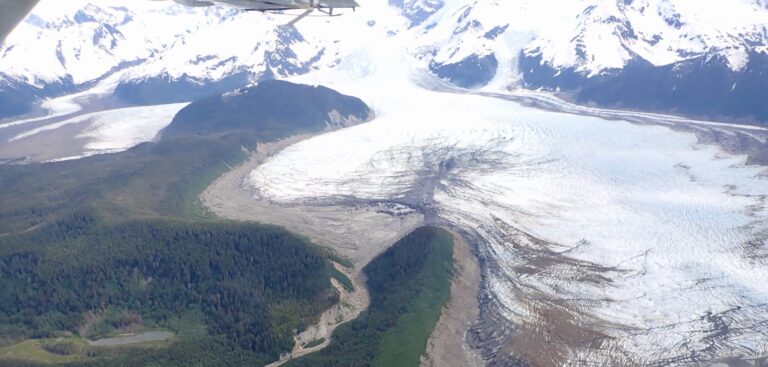A study of a rapidly advancing and retreating glacier in Alaska has indicated that the cool microclimate around the snout of a glacier has a direct impact on the growth of surrounding woodland. The researchers say this provides greater insight into how forests may behave in a warmer future climate.
Tree ring growth depends on many factors including temperature. For certain species, cooler, drier conditions lead to slower growth and smaller or denser rings. The study, led by ecologist Ben Gaglioti of Columbia University and the University of Alaska Fairbanks, documents this relationship in the La Perouse glacier in Alaska and the surrounding Glacier Bay National Forest.
From historical accounts, tree cores and aerial imagery, the team knew the glacier rapidly advanced hundreds of meters during the late 1800s, moved rapidly back and forth during the early 1900s, and began retreating around 1950. The next step was to check if the trees recorded microclimate shifts during those periods.
Using 118 cores from the old-growth forest of yellow cedar, the team reconstructed temperatures from 1855 to 2021. After considering regional temperatures and elevation, the researchers found a clear slowdown of growth as the glacier advanced and an increase in growth rates as it retreated. The glacier advance cooled the forest almost 4°C in the summer.
“That was stunning to me,” said Gaglioti. “Because of the glacier’s advance and retreat, the La Perouse forest experienced some of the fastest rates of historical cooling and warming on Earth, but climate models indicate these rates of change will become more common in the next century. Studying these types of glacier-adjacent ecosystems can help us understand how they may respond to the unprecedented rate of warming in the future.”
Gaglioti and his colleagues stumbled onto the find while studying once-buried layers of trees that had been plowed down by glaciers in the 19th century. While sampling the rainforest trees just outside the glacier’s footprint, they noticed the tree rings had compressed growth during the late 1800s as the glacier advanced, pushing its bubble of cold air out into the woods.
“Then we had this idea to monitor the size and intensity of the cold microclimate around the ice using temperature sensors,” Gaglioti said. “If the glacier went back and forth and this microclimate influenced the surrounding forest, we could use it as an experiment.”
A network of temperature sensors was installed for hundreds of meters surrounding La Perouse Glacier and collected the data for three years, from July 2018 to July 2021. The microclimate extended at least 600m into the forest, the farthest distance researchers had placed sensors. Without more distant sensors, “it’s hard to constrain where it actually ends,” Gaglioti said.
The findings also add an important source of information in reconstructing the movement of past glaciers and their influence on the surrounding biosphere. “If you look at trees that were run over by the ice, you can see the cooling effects as the ice approaches them, before they die,” Gaglioti said. The trees left behind offer important climate records as the glacier retreats, as well as insights into the rate of retreat and possible influences on ecological succession once the ice has gone.
There are five other tree species in La Perouse’s microclimate, and preliminary results suggest each species responds differently to climate changes. Gaglioti hopes he can use these records to better understand how a whole forest responds to large-magnitude cooling and warming.
To read the complete study in AGU’s Geophysical Research Letters, click here.



